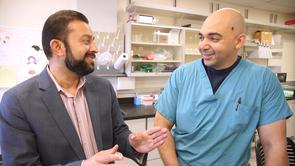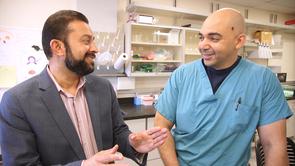
Credit: Photo: Bob Demers/UANews
After proving surprisingly beneficial in human clinical trials at the University of Arizona for the treatment of pain resulting from fibromyalgia and migraines, green light therapy now will be tested in a preclinical study to determine if it successfully can control HIV-related neuropathic pain.
Further, researchers at the UA College of Medicine – Tucson say in the future they plan to explore whether the non-invasive, inexpensive and apparently safe green light therapy successfully can treat a variety of other types of pain, such as cancer-related pain and postoperative pain, among others. They also want to figure out how the therapy actually works.
"To tell the truth, I am still surprised that our patients' pain is reduced by an average of 60 percent by using green light therapy," said Mohab Ibrahim, MD, PhD, an associate professor in the UA departments of anesthesiology and pharmacology and principal investigator for the new study, which has been funded with a $1.72 million grant from the National Institutes of Health. "It doesn't take your pain entirely away. But when you speak to most of these patients, they say it's life changing."
Dr. Ibrahim, who also is director of the Chronic Pain Management Clinic at Banner – University Medical Center, had an epiphany after he noted his brother, Wael, who lives in San Diego, treated his headaches by retreating to his verdant backyard.
"I would tell him to take an Advil or a Tylenol, but more often than not, he'd say, 'No. I just like to sit in my garden.' And by doing that he just feels better. So one day, I had a headache and no medication at home, and I stopped at Reid Park for 30 minutes and my headache improved. After giving it a lot of thought, I realized the most common thing between Reid Park and my brother's backyard is the color green."
He decided to experiment with green light. To better understand the effect of different wavelengths of light, Dr. Ibrahim's team's preclinical studies showed that green and blue LED produced analgesic effects in free-moving laboratory rats and reversed neuropathic pain associated with models of chronic pain.
"Lo and behold, the rats became analgesic. We repeated that experiment at least five times because the data were stunning. Frankly, I initially was in denial," he said.
The analgesic effects were completely blocked when the laboratory animals' eyes were covered, suggesting the effects mainly were due to systemic effects through the visual system. Preliminary experiments suggest this effect is mediated through the endogenous opioids and possibly cannabinoid system, according to ClinicalTrials.gov.
Dr. Ibrahim and his co-investigator, Rajesh Khanna, PhD, a professor in the UA departments of pharmacology, anesthesiology and neuroscience, are beginning a study funded by a $1.72 million grant from the National Center for Complementary and Integrative Health, part of the NIH, to study the mechanism of green LED in HIV-induced neuropathy. Disorders of peripheral nerves are among the most frequent neurological complications of HIV infection.
"And on top of that, the antiretroviral medications used to treat HIV can cause neuropathy. So when you combine the 20 to 30 percent of people who develop neuropathy from anti-retroviral medications, and the other group who normally develop neuropathy from HIV, you can see that this impacts a lot of individuals," Dr. Ibrahim said.
"Ultimately, we want to see if the green light therapy can lead to an improvement in HIV patients' pain and quality of life. And we want to determine how can something as simple as green light have these biological effects. Therefore, part of the new grant is to explore the circuitry in the brain and the spinal cord to understand how shining light through the visual system can have such profound effects. And once we find out the mechanisms, then we can optimize and manipulate the system to make it even more efficient."
Dr. Ibrahim notes that another major benefit of this therapy is that in preclinical studies it has provided a "synergistic" effect when combined with opioids. Thus, a smaller dose of the medication is needed, leading to less chance of addiction, side effects and other potential health issues. "If we could lower the dosage of opioids needed, we certainly could decrease the side effects and hopefully decrease the potential for addiction. This is certainly a potential tool to help address the opioid crisis."
"Green light therapy is a surprising and timely breakthrough for the treatment of pain," said UA President Robert C. Robbins, MD. "At a time when our nation and state are confronting a major opioid epidemic, and drug costs continue to soar, this safe and cost-effective treatment could play a major role in helping address the treatment of chronic pain. I look forward to seeing how this innovative research effort unfolds."
###
Other members of the UA research team include: Frank Porreca, PhD, professor and associate department head of the UA Department of Pharmacology; Todd Vanderah, PhD, professor and head of the UA Department of Pharmacology; Amol M. Patwardhan, MD, PhD, assistant professor of anesthesiology and co-director of the Comprehensive Pain Management Clinic; and T. Philip Malan, PhD, MD, professor emeritus of anesthesiology and professor of pharmacology.
This work was supported by the Department of Health and Human Services, National Institutes of Health, National Center for Complementary and Integrative Health, under award No. R01AT009716. Opinions, interpretations, conclusions and recommendations are those of the author and are not necessarily endorsed by the NIH.
About the UA College of Medicine – Tucson
The University of Arizona College of Medicine – Tucson is shaping the future of medicine through state-of-the-art medical education programs, groundbreaking research and advancements in patient care in Arizona and beyond. Founded in 1967, the college boasts more than 50 years of innovation, ranking among the top medical schools in the nation for research and primary care. Through the university's partnership with Banner Health, one of the largest nonprofit health care systems in the country, the college is leading the way in academic medicine. For more information, please visit medicine.arizona.edu
Media Contact
George Humphrey
[email protected]
520-626-7255
http://uahs.arizona.edu/
Original Source
http://uahs.arizona.edu/news/thanks-172m-federal-grant-ua-researchers-using-green-light-hiv-related-pain-astonishing-therapy





